A Novel Algorithm for Efficient Downlink Packet Scheduling for Multiple-Component-Carrier Cellular Systems
Abstract
:1. Introduction
2. Problem Description
2.1. System Model
2.2. Goal
3. Proposed Algorithm
3.1. Classic Proportional Fair Criterion
3.2. Proposed Efficient Packet Scheduling Algorithm
3.3. Baseline Scheduler
4. Results and Discussions
4.1. Throughput Comparison
4.2. Mean Packet Delay Comparison
4.3. Fairness Comparison
5. Conclusions
Acknowledgments
Conflicts of Interest
References
- Parkvall, S.; Astely, D. The evolution of LTE towards IMT-advanced. J. Commun. 2009, 4, 146–154. [Google Scholar] [CrossRef]
- Martín-Sacristán, D.; Monserrat, J.F.; Cabrejas-Peñuelas, J.; Calabuig, D.; Garrigas, S.; Cardona, N. On the way towards fourth-generation mobile: 3GPP LTE and LTE-advanced. EURASIP J. Wirel. Commun. Netw. 2009, 2009. [Google Scholar] [CrossRef]
- Andrews, J.G.; Buzzi, S.; Choi, W.; Hanly, S.V.; Lozano, A.; Soong, A.C.K.; Zhang, J.C. What will 5G be? IEEE J. Sel. Areas Commun. 2014, 32, 1065–1082. [Google Scholar] [CrossRef]
- Wu, J.; Zhang, Y.; Zukerman, M.; Yung, E.K.-N. Energy-efficient base-stations sleep-mode techniques in green cellular networks: A survey. IEEE Commun. Surv. Tutor. 2015, 17, 803–826. [Google Scholar] [CrossRef]
- Gupta, A.; Jha, R.K. A survey of 5G network: Architecture and emerging technologies. IEEE Access. 2015, 3, 1206–1232. [Google Scholar] [CrossRef]
- Hossain, E.; Hasan, M. 5G cellular: Key enabling technologies and research challenges. IEEE Instrum. Meas. Mag. 2015, 18, 11–21. [Google Scholar] [CrossRef]
- Han, F.; Zhao, S.; Zhang, L.; Wu, J. Survey of strategies for switching off base stations in heterogeneous networks for greener 5G systems. IEEE Access. 2016, 4, 4959–4973. [Google Scholar] [CrossRef]
- Jeong, S.S.; Jeong, D.G.; Jeon, W.S. Cross-layer design of packet scheduling and resource allocation in OFDMA wireless multimedia networks. In Proceedings of the IEEE Vehicular Technology Conference 2006-Spring, Melbourne, Australia, 7–10 May 2006.
- Madan, R.; Boyd, S.; Lall, S. Fast algorithms for resource allocation in wireless cellular networks. IEEE/ACM Trans. Netw. 2010, 18, 973–984. [Google Scholar] [CrossRef]
- Ng, D.W.K.; Lo, E.S.; Schober, R. Energy-efficient resource allocation in OFDMA systems with large numbers of base station antennas. IEEE Trans. Wirel. Commun. 2012, 11, 3292–3304. [Google Scholar] [CrossRef]
- Ng, D.W.K.; Lo, E.S.; Schober, R. Energy-efficient resource allocation in multi-cell OFDMA systems with limited backhaul capacity. IEEE Trans. Wirel. Commun. 2012, 11, 3618–3631. [Google Scholar] [CrossRef]
- Ng, D.W.K.; Lo, E.S.; Schober, R. Energy-efficient resource allocation in OFDMA systems with hybrid energy harvesting base station. IEEE Trans. Wirel. Commun. 2013, 12, 3412–3427. [Google Scholar] [CrossRef]
- Morosi, S.; Piunti, P.; del Re, E. Improving cellular network energy efficiency by joint management of sleep mode and transmission power. In Proceedings of the 24th Tyrrhenian International Workshop on Digital Communications-Green Information and Communication Technology, Genova, Italy, 23–25 September 2013.
- Chung, Y.-L. Energy-saving transmission for green macrocell-small cell systems: A system-level perspective. IEEE Syst. J. 2016, 99, 1–11. [Google Scholar] [CrossRef]
- Lei, L.; Zheng, K. Performance evaluation of carrier aggregation for elastic traffic in LTE-advanced systems. IEICE Trans. Commun. 2009, 92, 3516–3519. [Google Scholar] [CrossRef]
- Chen, L.; Chen, W.; Zhang, X.; Yang, D. Analysis and simulation for spectrum aggregation in LTE-advanced system. In Proceedings of the IEEE Vehicular Technology Conference 2009-Fall, Anchorage, AK, USA, 20–23 September 2009.
- Takeda, K.; Nagata, S.; Kishiyama, Y.; Miki, N.; Tanno, M. Effects of wideband scheduling and radio resource assignment in OFDMA radio access for LTE-advanced downlink. In Proceedings of the IEEE Vehicular Technology Conference 2009-Fall, Anchorage, AK, USA, 20–23 September 2009.
- Songsong, S.; Chunyan, F.; Caili, G. A resource scheduling algorithm based on user grouping for LTE-advanced system with carrier aggregation. In Proceedings of the International Symposium on Computer Network and Multimedia Technology, Wuhan, China, 18–20 December 2009.
- Chung, Y.-L.; Tsai, Z. A quantized water-filling packet scheduling scheme for downlink transmissions in LTE-advanced systems with carrier aggregation. In Proceedings of the IEEE Software, Telecommunications and Computer Networks, Split, Croatia, 23–25 September 2010.
- Wang, H.; Rosa, C.; Pedersen, K.I. Radio resource management for uplink carrier aggregation in LTE-advanced. EURASIP J. Wirel. Commun. Netw. 2015, 2015. [Google Scholar] [CrossRef]
- Sundaresan, K.; Rangarajan, S. Energy efficient carrier aggregation algorithms for next generation cellular networks. In Proceedings of the IEEE International Conference on Network Protocols, Gottingen, Germany, 7–11 October 2013.
- Chen, H.; Jiang, Y.; Xu, J.; Hu, H. Energy-efficient coordinated scheduling mechanism for cellular communication systems with multiple component carriers. IEEE J. Sel. Areas Commun. 2013, 31, 959–968. [Google Scholar] [CrossRef]
- Chung, Y.-L. Rate-and-power control based energy-saving transmissions in OFDMA-based multicarrier base station. IEEE Syst. J. 2015, 9, 578–584. [Google Scholar] [CrossRef]
- Chung, Y.-L. Energy-efficient transmissions for green base stations with a novel carrier activation algorithm: A system-level perspective. IEEE Syst. J. 2015, 9, 1252–1263. [Google Scholar] [CrossRef]
- Chung, Y.-L. A novel power-saving transmission scheme for multiple-component-carrier cellular systems. Energies 2016, 9, 265. [Google Scholar] [CrossRef]
- Chung, Y.-L.; Tsai, Z.; Yang, C.-H. A study of quota-based dynamic network selection for multimode terminal users. IEEE Syst. J. 2014, 8, 759–768. [Google Scholar] [CrossRef]
- Kelly, F.P.; Maulloo, A.; Tan, D. Rate control for communication networks: Shadow prices, proportional fairness and stability. J. Oper. Res. Soc. 1998, 49, 237–252. [Google Scholar] [CrossRef]
- Lee, S.-B.; Choudhury, S.; Khoshnevis, A.; Xu, S.; Lu, S. Downlink MIMO with frequency-domain packet scheduling for 3GPP LTE. In Proceedings of the IEEE Conference on Computer Communications, Rio de Janeiro, Brazil, 19–25 April 2009.
- Goldsmith, A. Wireless Communication; Cambridge University Press: Cambridge, UK, 2005. [Google Scholar]
- Jalali, A.; Padovani, R.; Pankaj, R. Data throughput of CDMA-HDR a high efficiency-high date rate personal communication wireless system. In Proceedings of the IEEE Vehicular Technology Conference 2000-Spring, Tokyo, Japan, 15–18 May 2000.
- Agrawal, D.P.; Zeng, Q.-A. Introduction to Wireless & Mobile Systems, 4th ed.; CENGAGE Learning: Boston, MA, USA, 2016. [Google Scholar]
- European Commission. COST Action 231: Digital Mobile Radio towards Future Generation Systems: Final Report; European Commission: Brussels, Belgium, 1999. [Google Scholar]
- Hayes, J.F.; Babu, T. Modeling and Analysis of Telecommunication Networks, 2nd ed.; Wiley-Interscience: Hoboken, NJ, USA, 2004. [Google Scholar]
- Jain, R.; Chiu, D.-M.; Hawe, W. A Quantitative Measure of Fairness and Discrimination for Resource Allocation in Shared Computer Systems. Available online: http://www.cse.wustl.edu/~jain/papers/ftp/fairness.pdf (accessed on 1 April 2016).
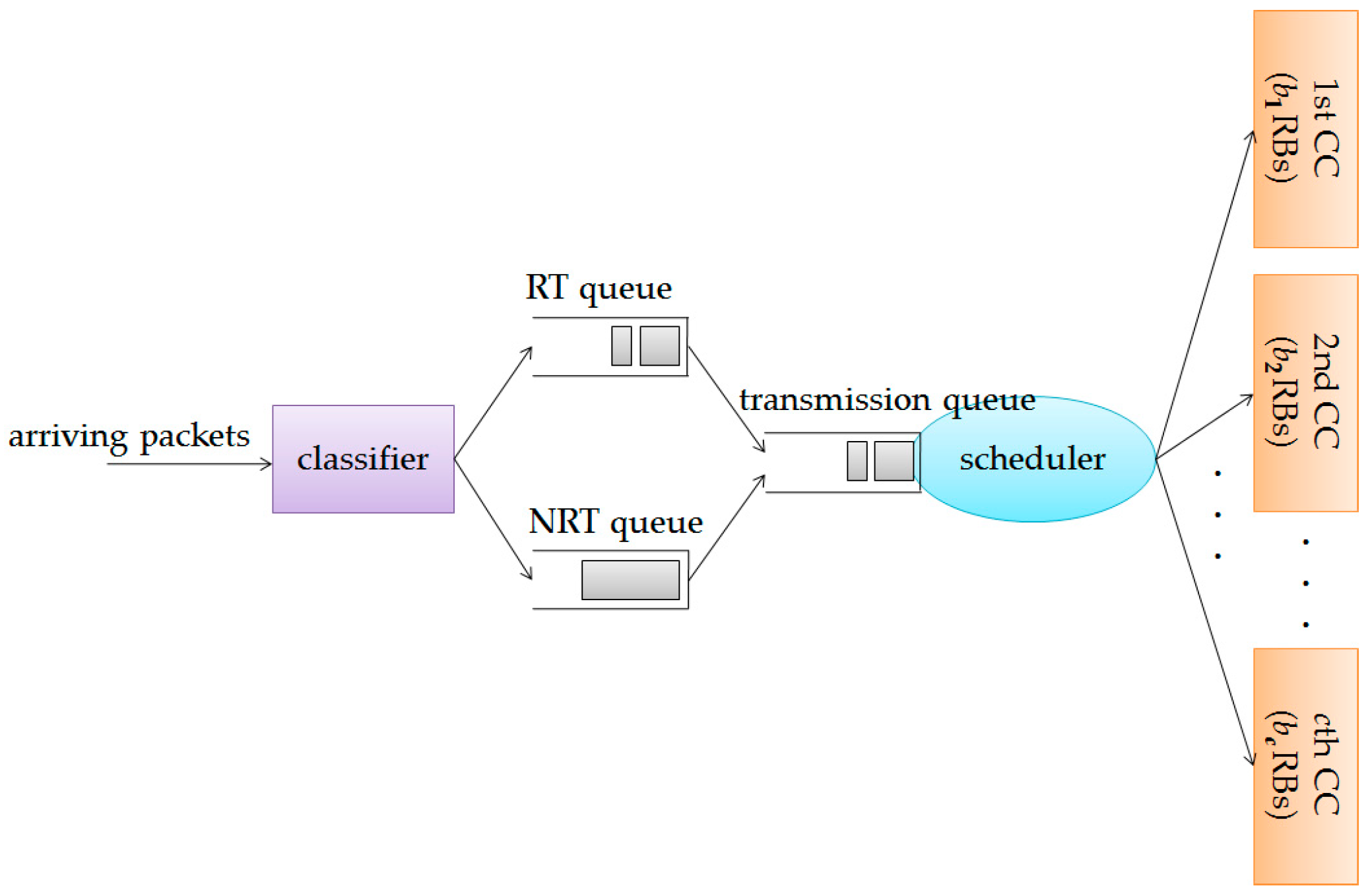
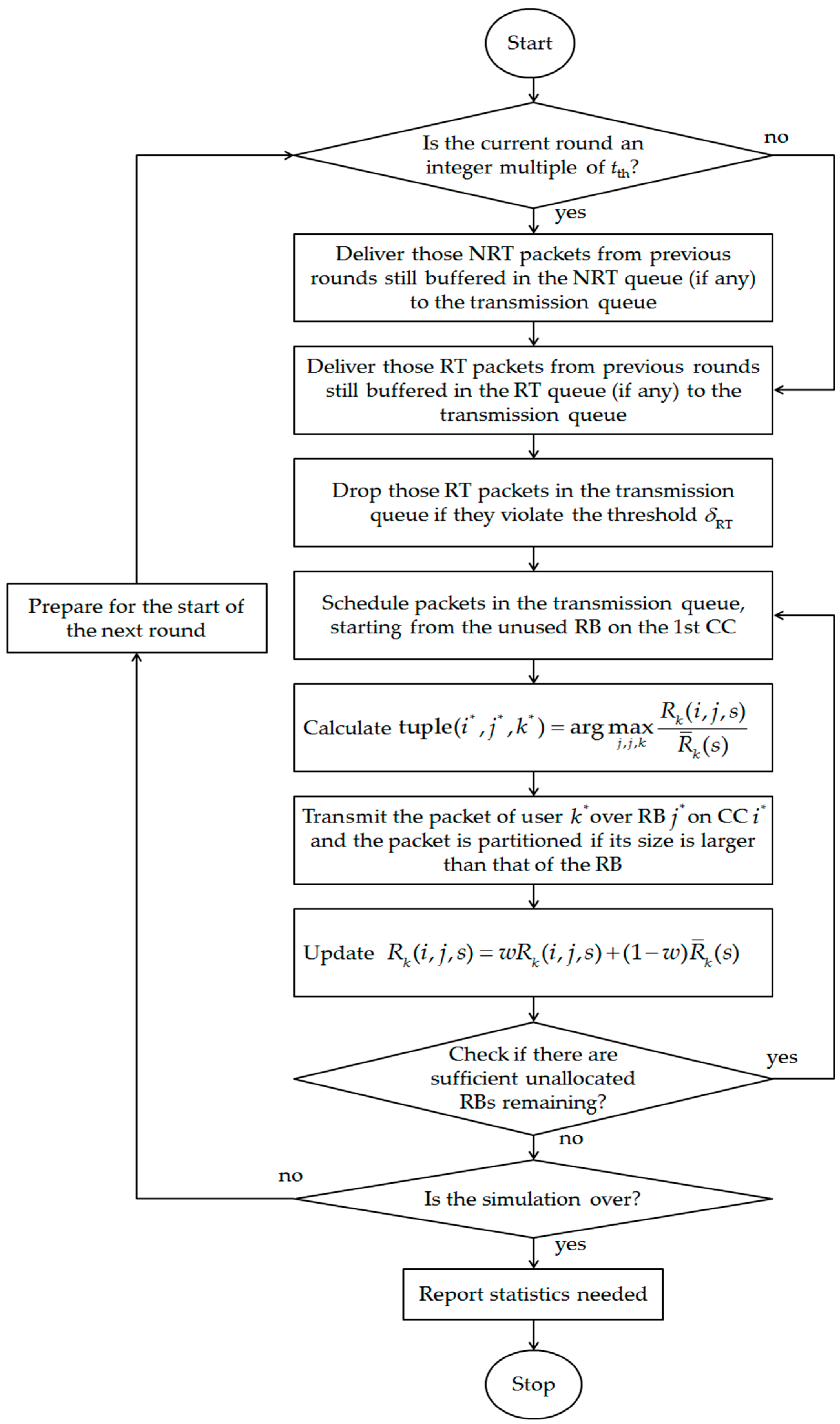
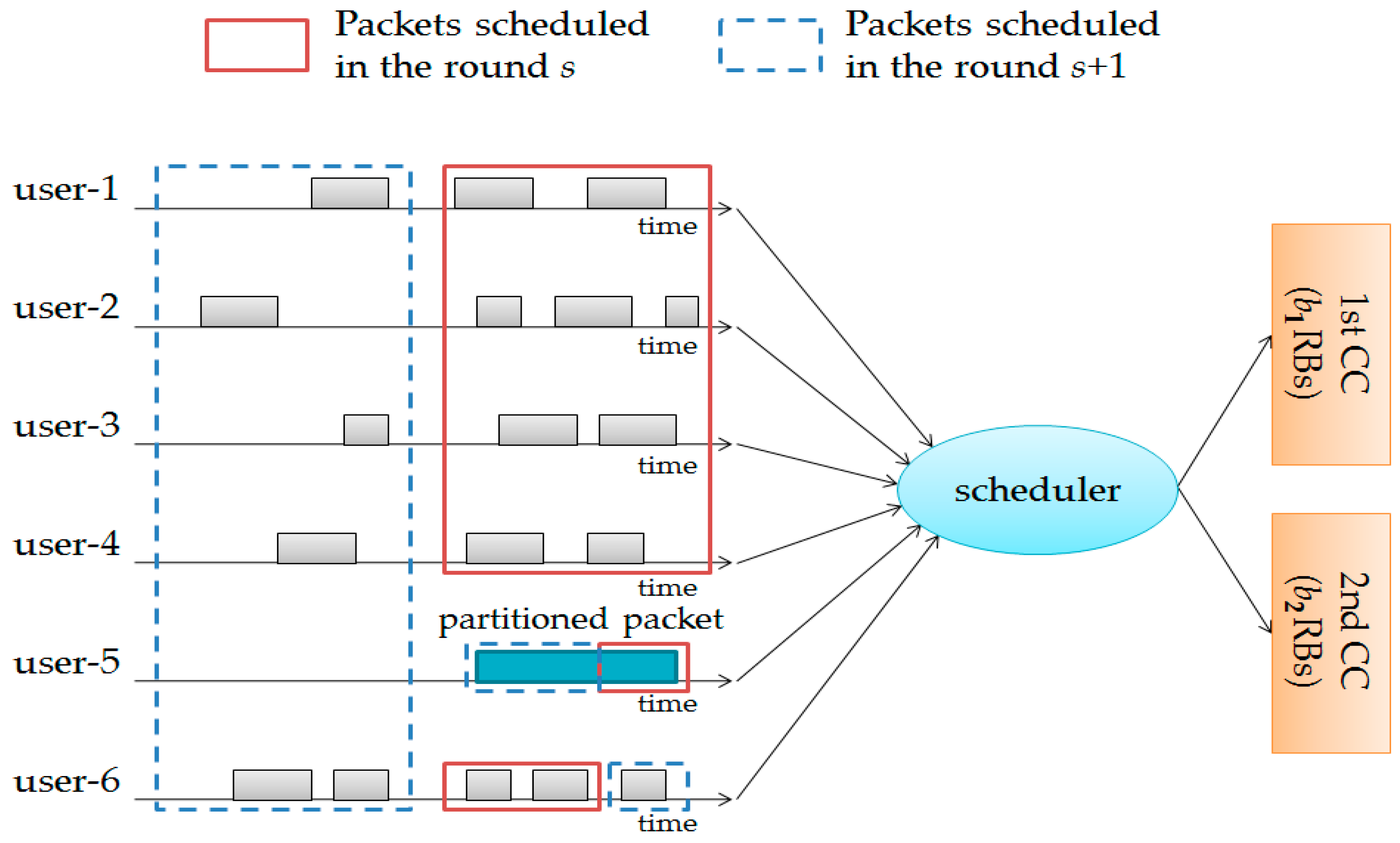
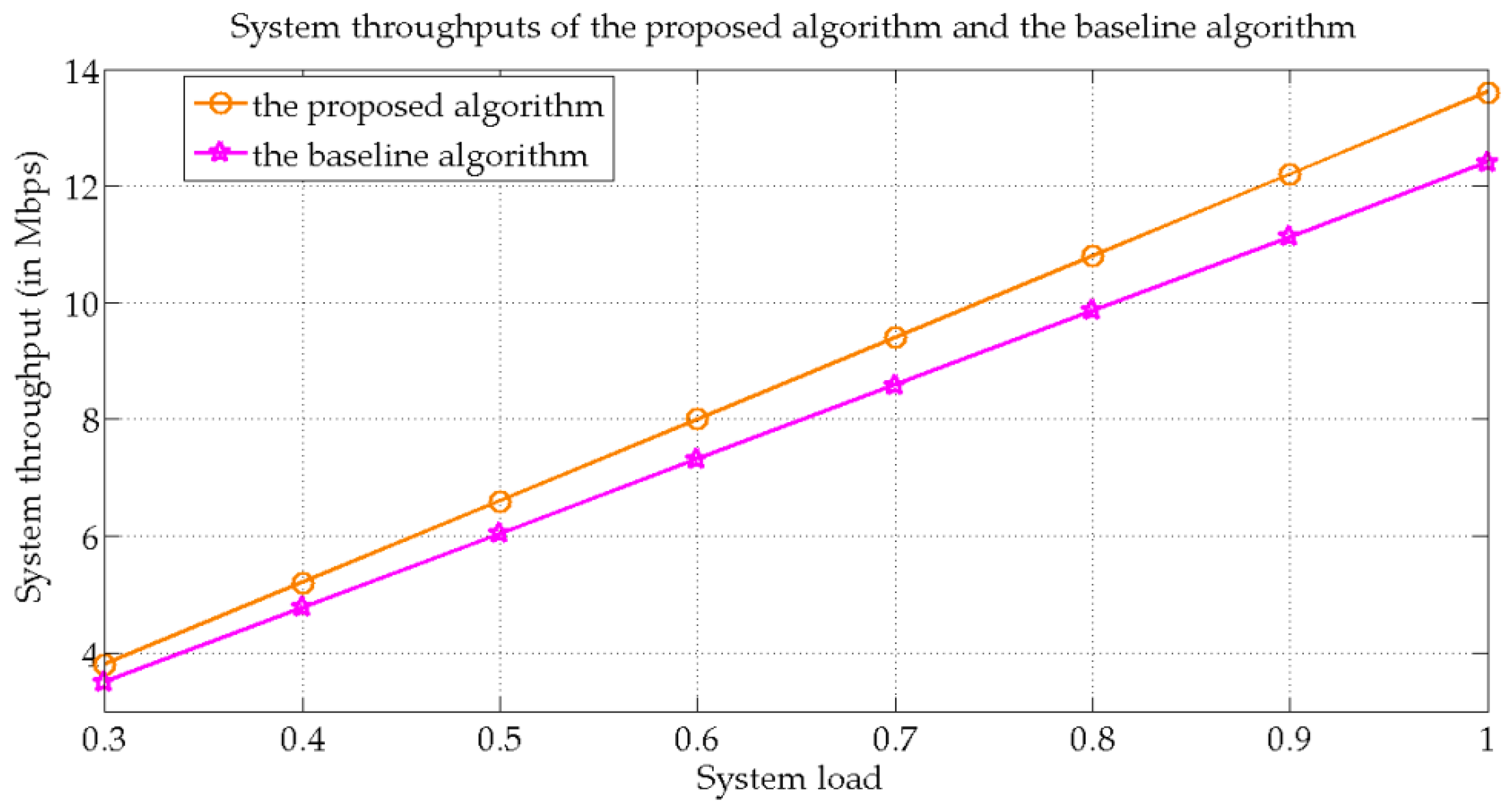
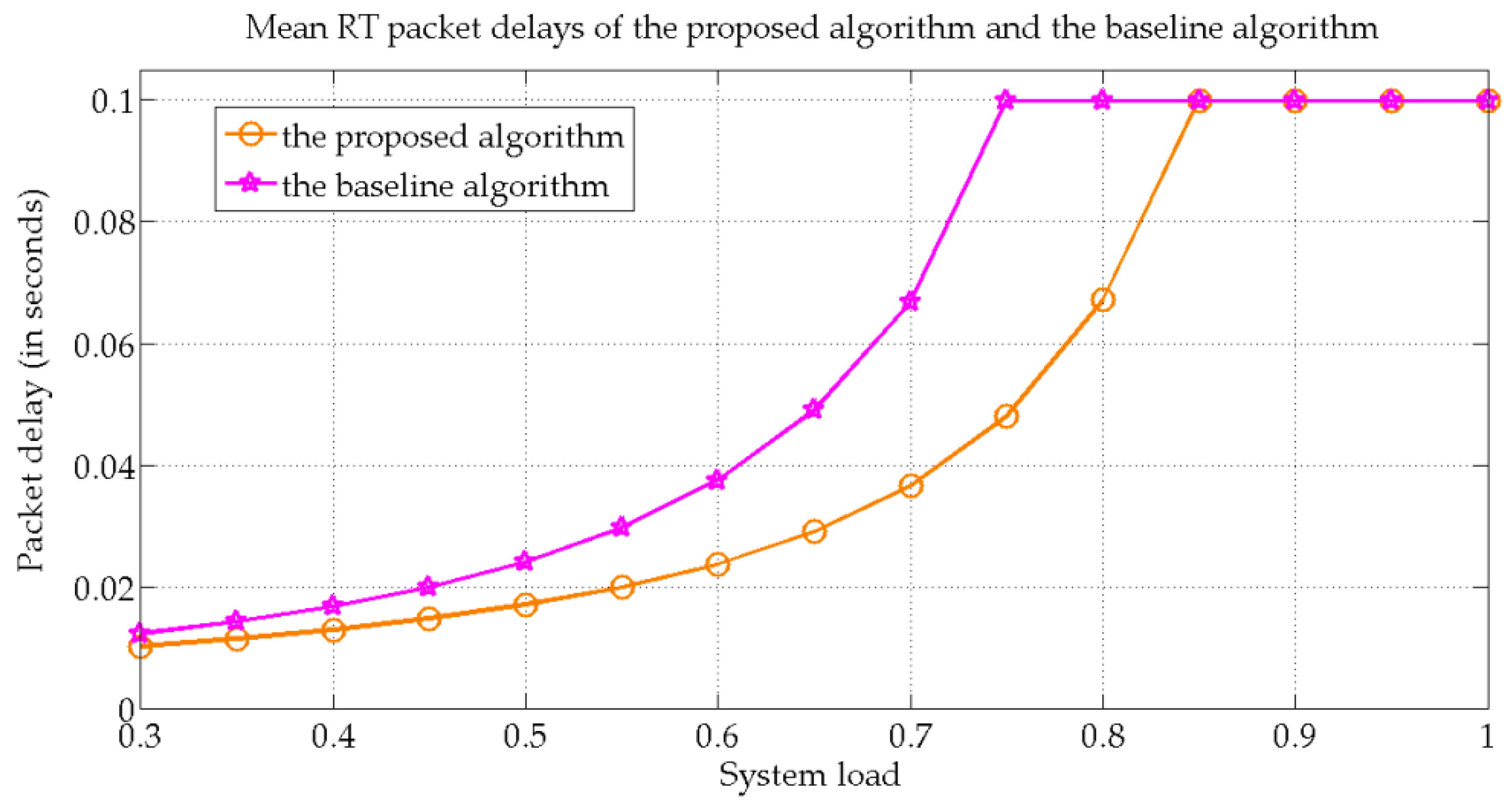
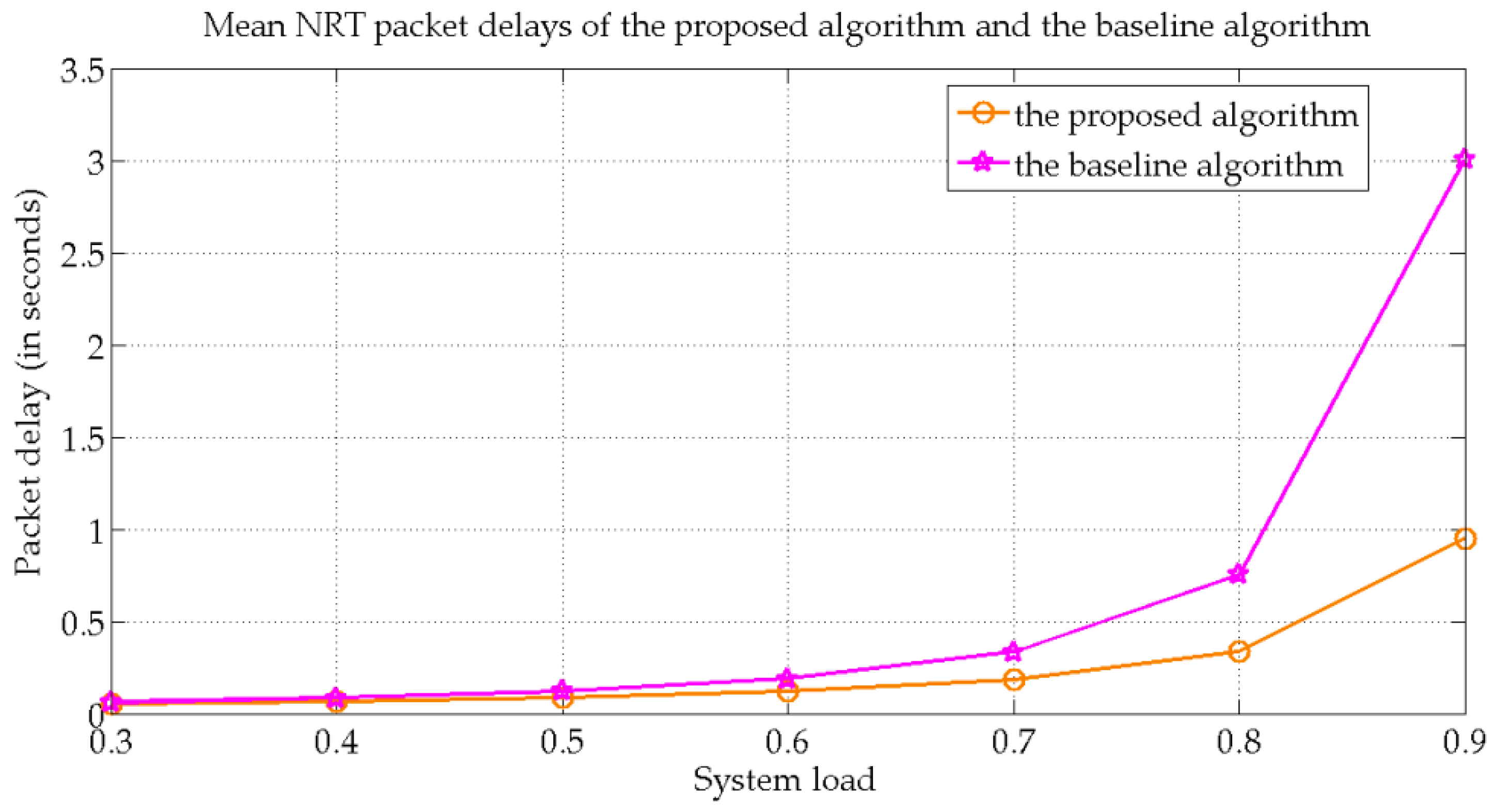
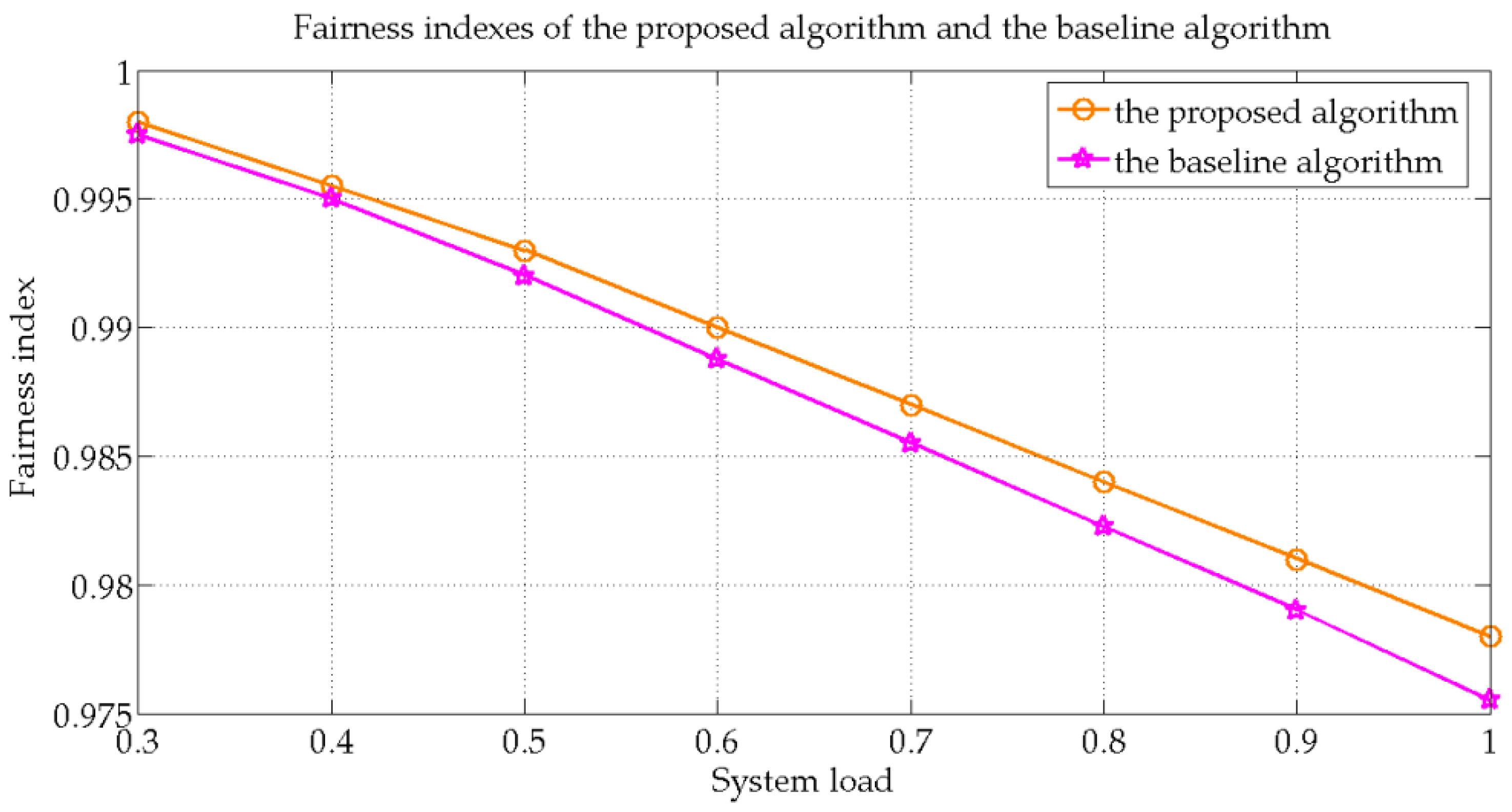
| Mean Delay (in Seconds) | System Load | ||||
|---|---|---|---|---|---|
| 0.3 | 0.5 | 0.7 | 0.9 | ||
| RT packets | = 1/4 | 0.010 | 0.016 | 0.032 | 0.1 |
| = 1/2 | 0.010 | 0.017 | 0.037 | 0.1 | |
| = 3/4 | 0.012 | 0.020 | 0.045 | 0.1 | |
| NRT packets | = 1/4 | 0.0624 | 0.1295 | 0.3572 | 1.9830 |
| = 1/2 | 0.0512 | 0.0849 | 0.1826 | 0.9487 | |
| = 3/4 | 0.0274 | 0.0337 | 0.1095 | 0.7152 | |
© 2016 by the author; licensee MDPI, Basel, Switzerland. This article is an open access article distributed under the terms and conditions of the Creative Commons Attribution (CC-BY) license (http://creativecommons.org/licenses/by/4.0/).
Share and Cite
Chung, Y.-L. A Novel Algorithm for Efficient Downlink Packet Scheduling for Multiple-Component-Carrier Cellular Systems. Energies 2016, 9, 950. https://doi.org/10.3390/en9110950
Chung Y-L. A Novel Algorithm for Efficient Downlink Packet Scheduling for Multiple-Component-Carrier Cellular Systems. Energies. 2016; 9(11):950. https://doi.org/10.3390/en9110950
Chicago/Turabian StyleChung, Yao-Liang. 2016. "A Novel Algorithm for Efficient Downlink Packet Scheduling for Multiple-Component-Carrier Cellular Systems" Energies 9, no. 11: 950. https://doi.org/10.3390/en9110950






